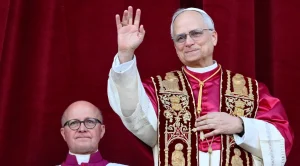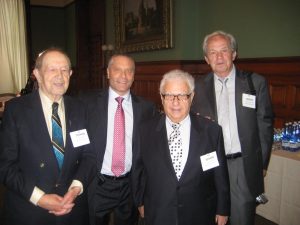When a west Winnipeg Catholic church held a panel discussion last month featuring four Jewish Holocaust survivors speaking about their suffering, close to 300 Catholics listened with rapt attention.
The fact this kind of event could take place at all – and that it’s not seen as anything unusual – is a testament to the revolution in Catholic-Jewish relations brought about by Nostra Aetate (In Our Time), the encyclical introduced by Pope John XXIII that was subsequently ratified by the Second Vatican Council and promulgated by his successor, Pope Paul VI, on Oct. 28, 1965.
The Oct. 21 program was one of a series hosted by Mary, Mother of the Church to commemorate the 50th anniversary of Nostra Aetate.
“Father Kevin Bettens [the church’s spiritual leader] and I became aware of the 50th anniversary and felt that our church should do something to commemorate the event,” said parishioner Greg Barrett, who moderated the evening. “We approached Rabbi Allan Green of Congregation Shaarey Zedek to ask for his support and also spoke with other Christian denominations.”
In his opening remarks, Barrett spoke of the importance of Nostra Aetate in promoting dialogue, understanding and reconciliation between Jews and Catholics, a policy that, he noted, Pope Francis fully endorses.
He described Nostra Aetate as “a call to love” and spoke of anti-Semitism as the “longest hatred.”
“For 1,600 years, Catholics were taught contempt for Jews,” he said. “That teaching prepared the ground for the Holocaust and the murder of six million Jews.”
Stefan Carter, Morris Faintuch, Barbara Goszer and Walter Saltzberg were Jewish children living in Poland in 1939 when the Nazis invaded. They each in turn described their struggle to survive.
Saltzberg and Carter were born in Warsaw. Carter was from an assimilated, well-to-do Jewish family who spoke Polish in the home. He spoke about moving into the ghetto and its horrendous conditions, as well as efforts by Jews to carry on a semi-normal life with secret schools, underground newspapers, theatre and concerts.
He was able to leave thanks to a bribe paid to a guard. He had cousins on the outside – one married to a Polish woman – who hid him in their apartment for the duration of the war.
Saltzberg recounted that he had been on his own from age 10. For three years, a Christian doctor sheltered him. In the waning years of the war, a young Jewish man took care of him.
Saltzberg’s luck almost ran out when the apartment he was hiding in was hit by a bomb. He was trapped in rubble up to his neck and suffered a broken leg. A friend pulled him out, but he couldn’t get treatment for his leg. Combined with later having to hide in an underground bunker for five months with little room to move, Saltzberg was left with one leg shorter than the other.
Morris Faintuch was from Lodz and was 10 when the war began. After his parents were killed, he and an older brother struggled to survive. Faintuch left the ghetto and lived as best he could outside. In March 1944, he was captured and sent to Auschwitz. He raised his sleeve to show his number on his arm, noting that it became his name.
Barbara Goszer, from Lvov, was nine when her parents managed to smuggle her out of the ghetto and place her with a Christian family. After a while, the family moved with her to a small town where she went to school and attended church regularly with the family.
“I could have become Catholic after the war,” she said. “I became very close with my adopted family. But I felt it was important to remain Jewish and serve as a witness to the Holocaust.”
Goszer, Carter and Saltzberg came directly to Winnipeg in the late 1940s as war orphans, while Faintuch arrived in 1953 after living in Israel for a few years. He had grandparents and an older brother here who had come before the war.
The Nostra Aetate commemorations actually began a week earlier with a presentation on anti-Semitism by Father Sam Argenziano of Holy Rosary Church in Winnipeg. The final program in the series was Oct. 28 and featured Rabbi Green speaking about Judaism.






